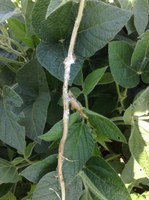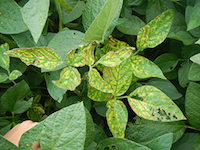Hello,
As a result of the water quality problems in the western basin of Lake Erie, funding has been made available to Hardin County farmers who have land in the Lake Erie watershed. This is basically land north of State Route 309. Funding is available through the Hardin SWCD and NRCS until Tuesday, August 26. This funding is to plant cover crops, install blind inlets and drainage control structures. See Megan Burgess at the Soil and Water Conservation District office to find out if you qualify. Some programs are first come, first served with a one page application while others are more involved and require a competitive process.
In the month of July, Extension rainfall reporters recorded an average of 2.85 inches of rain in Hardin County. Last year, the average rainfall for July was 7.4 inches. With the exception of three townships, this past month was a dry month as rainfall was 1.31 inches below the ten year average rainfall for the month of July. To read more about the July rainfall, see the attached news release. Our Master Gardener Volunteers have also been putting together a fall course for new MGV interns. Read the attached article to find out more about this training course which will start on September 23, and end on November 20. If you know someone who would like to become a Master Gardener Volunteer, have them contact the Extension office.
New Master Gardener Volunteer Course News Release
Finally, I would like to invite everyone to our 100th Anniversary Celebration of Cooperative Extension program which will be held Sunday, September 7. This event will highlight the past, present, and future of Extension work and will take place in the demonstration area of the Community Building from 2:00-4:00 pm during the fair. See the attached article and flier prepared by Kathy Oliver for more details. Upcoming events this week include Master Gardener meeting on August 25, starting at 7:00 pm at Harco Industries. The Fairboard will be meeting August 30, starting at 7:30 at the fairgrounds office. I have included some articles below that might be of interest to you along with an attached article written by Ed Lentz, Hancock County Extension on late season soybean pests.
100 Year Celebration of Extension
Late Season Soybean Pests Courier News Release
Mark
WHITE MOLD OR SCLEROTINIA STEM ROT IS HERE – Anne Dorrance
This disease is caused by the fungus, Sclerotinia sclerotiorum and it is favored by cool damp conditions. Remember those morning fogs this summer and the fact that you hardly used your air conditioner? Perfect conditions for infection. This fungus forms hard black irregular shaped bodies called sclerotia. They are actually a mass of hyphae and if you break them open they will be pink inside. They can be mistaken for mice or rat droppings as well, the inside is a different color! When the conditions are cool and the canopy is closed, this fungus produces a very small mushroom. This usually occurs during flowering and the spores then land on the dead flowers. This provides a perfect point of entry. To read more about White Mold, go to http://corn.osu.edu/newsletters/2014/2014-27/white-mold-or-sclerotinia-stem-rot-is-here.
The grain fill period begins with successful pollination and initiation of kernel development, and ends approximately 60 days later when the kernels are physiologically mature. During grain fill, the developing kernels will be the primary sink for concurrent photosynthate produced by the corn plant. What this means is that the photosynthate demands of the developing kernels will take precedence over that of much of the rest of the plant. In essence, the plant will do all it can to “pump” dry matter into the kernels, sometimes at the expense of the health and maintenance of other plant parts including the roots and lower stalk. Go to http://extension.entm.purdue.edu/pestcrop/2014/issue18/index.html.
SOYBEAN APHID UPDATE FOR 2014 – Andy Michel
For the most part, soybean aphids have been a problem only in odd numbered years. Several other states have broken this two-year cycle, but it has held in Ohio for over 10 years. Recently, we have been noticing the presence of soybean aphids in soybean, mostly in the northern and central part of the state. While the majority of fields have extremely low numbers, a few fields have reached 75-100 aphids per plant. Usually, in even numbered years, non-economic soybean aphid populations are found in soybean—these aphids will provide the migratory populations needed to overwinter on buck-thorn and form populations the following year. To finish reading this article and to access the OSU Fact Sheet, go to http://corn.osu.edu/newsletters/2014/2014-27/soybean-aphid-update-for-2014.
SUDDEN DEATH SYNDROME AND BROWN STEM ROT IN SOYBEAN – Kiersten Wise – Purdue
Sudden death syndrome, or SDS, has been observed in soybean fields in Indiana over the last week. The fungus that causes SDS, Fusarium virguliforme, infects soybean early, and symptoms are typically expressed later in the growing season. Many soybeans throughout Indiana emerged from wet soils this spring, and growers should be watching for symptoms of SDS in fields over the next few weeks. Symptoms of SDS are expressed as interveinal yellowing and necrosis. Veins of symptomatic leaves will remain green. Leaflets will curl or shrivel and drop off with only the petiole remaining. Go to http://extension.entm.purdue.edu/pestcrop/2014/issue19/index.html to continue reading this article as well as to view an accompanying video.
MANURE SPILL RESPONSE KIT – Rory Lewandowski
Handling and hauling manure is tied to livestock production. Manure application involves the farmer juggling a number of factors such as weather conditions, soil moisture, soil nutrient level, crop nutrient needs, application method, soil type, and slope to insure that manure is applied correctly and in an environmentally friendly manner. In every situation there may be factors outside of the farmers control and sometimes those factors result in a manure spill. How prepared the farmer is to react to that spill can make the difference between a small accident or a large environmental and/or regulatory incident. Recently I read an article about preparedness for manure spills in a dairy herd.com newsletter that contained information about a manure spill kit. Go to http://beef.osu.edu/beef/beefAug1314.html to finish reading this article.
Mark A. Badertscher
Agriculture and Natural Resources Educator
OSU Extension Hardin County
1021 W. Lima Street, Suite 103, Kenton, OH 43326
419-674-2297 Office
hardin.osu.edu





